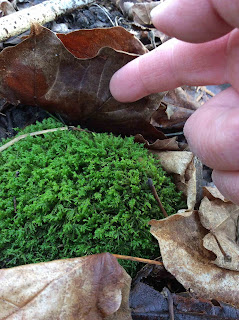 |
| Little Rouge woodland |
It had been
a while since I’d visited the Little Rouge woodland. After returning early last
fall from a trip to see the magnificent old-growth forest in British Columbia,
I went back to my teaching at the University of Toronto and nursed my broken
ankle (received not in the wilderness of ancient forests but during a mishap at
a garden party!). I hobbled in a boot and used a cane to get around the city. As
much as I longed to see my favourite woodland, I’d wisely decided not to
venture into the rough uneven ground of the forest—until I could walk without a
cane.
It was a
brisk January day in winter, when I finally returned to the Little Rouge, ready
to scramble down its banks for treasure. The Little Rouge was partially iced
over as water rushed clear downstream. Water gurgled under the ice, dislodging
some into moving islands. I watched—mesmerized—as the water carried one large
ice drift that cracked and groaned until it piled onto another ice sheet
downstream. More water gurgled in swirling patterns beneath the ice like a
living watercolour.
 |
| Patterns on cedar log |
Inspired, I
decided to get up-close and personal with my favourite woodland and search the
winter forest for things unseen. On first inspection, the forest lay draped in
the browns and greys of winter, dusted by pockets of snow and ice. The trees
were bare and gave me a clear view into the heart of the woodland and its
rust-coloured monochrome of dead and decaying leaves and litter.
I focused
on the forest floor and on nearby trees and shrubs for hidden gifts. One fallen
cedar log revealed swirling impressionistic patterns of wood grain, dusted with
moss and lichen.
Embedded in
the ice of the litter-strewn path, I saw a half-eaten Black Walnut shell—likely
dropped there by a squirrel. I found other seeds, dropped in a cedar stand amid
a bed of leaves. On close inspection, the leaves revealed a multitude of
colours, shades, shapes and textures. Blue, gold, red, and yellow popped amid
the ubiquitous brown.
 |
| Moss hiding under leaves |
When I
poked at the leaves, I found surprising rewards beneath. Pockets of bright
green mosses. Islands of young moss colonized the large granite rocks placed
along the path. Mosses thrive in the wet winter and spring. Even when covered
in snow, moss continues its growth cycle, usually in the leafy gametophyte
stage. When the winter is moderate, like it is near Toronto, sporophyte
structures can already appear on stalks that hold a capsule full of spores. In the spring the capsules release spores that
can each create a new moss individual.
Many twigs
strewn on the leaf-covered forest floor were covered in grey-green lichen with
leaf-like, lobes. On close inspection, the lichen thallus contained abundant cup-shaped
fruiting bodies. These lichen were most likely Physchia
stellaris, common and widespread in Ontario that typically pioneers
on the bark of twigs—especially of poplars, and alders.
 |
| Physchia stellari lichen with fruiting bodies on a twig |
A lichen is
actually a complex symbiotic association of two or more fungi and algae. The
algae in lichens (called phycobiont or photobiont) photosynthesize and the
fungus (mycobiont) provides protection for the photobiont. Both the algae and
fungus absorb water, minerals, and pollutants from the air, through rain and
dust. In sexual reproduction, the mycobiont produces fruiting bodies, often
cup-shaped, called apothecia that release ascospores. The spores must find a
compatible photobiont to create a lichen.
Lichens
also reproduce asexually in two ways. One way is through fragmentation; a
portion of the thallus simply breaks off and starts a new colony. The second
way is through vegetative structures called soredia—algal cells surrounded by
fungal filaments or hyphae—which form in the thallus. In the right conditions,
they burst through the surface of the thallus and as propagules (such as a stem
cuttings, portions of root, seeds or spores) can propagate more of themselves.
A lichen might also develop a specific vegetative extension called isidia that
fragments as a propagule to create more lichen.
The sun was
setting by the time I made my way out of the Little Rouge woodland, soul refreshed
and smiling in my many discoveries.
Nina is a Canadian scientist and novelist. She worked for 25 years as an environmental consultant in the field of aquatic ecology and limnology, publishing papers and technical reports on water quality and impacts to aquatic systems. Nina has written over a dozen eco-fiction, science fiction and fantasy novels. An award-winning short story writer, and essayist, Nina currently lives in Toronto where she teaches writing at the University of Toronto and George Brown College. Her non-fiction book “Water Is...”—a scientific study and personal journey as limnologist, mother, teacher and environ- mentalist—was picked by Margaret Atwood in the New York Times as 2016 ‘The Year in Reading’. Nina’s most recent novel “A Diary in the Age of Water”— about four generations of women and their relationship to water in a rapidly changing world—will be released in May 2020 by Inanna Publications. www.NinaMunteanu.ca; www.NinaMunteanu.me

No comments:
Post a Comment